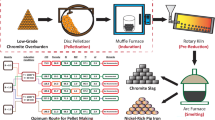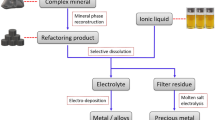Abstract
With gradually diminishing Fe grade in tandem with the ever-increasing demand for high-grade iron ores, iron ore industries are now focusing on the beneficiation of low-grade iron ore fines, mainly considered waste. Besides, the scarcity of water at many of the mines’ sites and the new water conservation policies of the governments have necessitated research on suitable dry beneficiation routes. In this context, an effort has been made to evaluate the efficacy of a dry classification unit, such as the VSK separator, in upgrading the iron values of two low-grade Indian iron ore fines, named Sample 1 and Sample 2. The mineralogical studies, involving scanning electron microscopy and X-ray diffraction, suggest that Sample 1 is a low-grade blue dust sample (51.2wt% Fe) containing hematite and quartz as the major minerals, while Sample 2 (53.3wt% Fe) shows the presence of goethite in addition to hematite and quartz. The experiments, carried out using Box—Benkhen statistical design, indicate that blower speed, followed by feed rate, is the most influencing operating parameter in obtaining a good product in the VSK separator. At optimum levels of the operating factors, a fines product with ∼55wt% Fe at a yield of ∼40% can be obtained from Sample 1, while Sample 2 can be upgraded to ∼56wt% Fe at a yield of ∼85%. The results suggest that the VSK separator can be employed as an efficient intermediate unit operation in a processing circuit to upgrade the iron contents of iron ore fines.
Similar content being viewed by others
References
U.S. Geological Survey, Mineral Commodity Summaries 2021, U.S. Geological Survey, Reston, 2021, p. 200.
N. Ray, D. Nayak, N. Dash, and S.S. Rath, Utilization of low-grade banded hematite jasper ores: Recovery of iron values and production of ferrosilicon, Clean Technol. Environ. Policy, 20(2018), No. 8, p. 1761.
S.K. Roy, D. Nayak, and S.S. Rath, A review on the enrichment of iron values of low-grade Iron ore resources using reduction roasting-magnetic separation, Powder Technol., 367(2020), p. 796.
S.S. Rath, H. Sahoo, and B. Das, Optimization of flotation variables for the recovery of hematite particles from BHQ ore, Int. J. Miner. Metall. Mater., 20(2013), No. 7, p. 605.
S. Mahiuddin, S. Bondyopadhway, and J.N. Baruah, A study on the beneficiation of Indian iron-ore fines and slime using chemical additives, Int. J. Miner. Process., 26(1989), No. 3–4, p. 285.
M.P. Srivastava, S.K. Pan, N. Prasad, and B.K. Mishra, Characterization and processing of iron ore fines of Kiriburu deposit of India, Int. J. Miner. Process., 61(2001), No. 2, p. 93.
H.J. Haselhuhn, J.J. Carlson, and S.K. Kawatra, Water chemistry analysis of an industrial selective flocculation dispersion hematite ore concentrator plant, Int. J. Miner. Process., 102–103(2012), p. 99.
P. Dixit, D. Makhija, A.K. Mukherjee, V. Singh, A. Bhatanagar, and R.K. Rath, Characterization and beneficiation of dry iron ore processing plant reject fines to produce sinter/pellet grade iron ore concentrate, Min. Metall. Explor., 36(2019), No. 2, p. 451.
K. Tudu, S. Pal, and N.R. Mandre, Comparison of selective flocculation of low grade goethitic iron ore fines using natural and synthetic polymers and a graft copolymer, Int. J. Miner. Metall. Mater., 25(2018), No. 5, p. 498.
G. Jimbo, M. Yamazaki, J. Tsubaki, and T.S. Suh, Mechanism of classification in a sturtevant-type air classifier, Chem. Eng. Commun., 34(1985), No. 1–6, p. 37.
S.K. Tripathy, P.K. Banerjee, N. Suresh, Y.R. Murthy, and V. Singh, Dry high-intensity magnetic separation in mineral industry—A review of present status and future prospects, Miner. Process. Extr. Metall. Rev., 38(2017), No. 6, p. 339.
V. Nunna, S. Hapugoda, S.G. Eswarappa, S.K. Raparla, M.I. Pownceby, and G.J. Sparrow, Evaluation of dry processing technologies for treating low grade lateritic iron ore fines, Miner. Process. Extr. Metall. Rev., 43(2022), No. 3, p. 283.
T. Kundu, S.K. Das, S.K. Tripathy, and S.I. Angadi, Performance evaluation of the VSK separator for treating mineral fines, Miner. Eng., 167(2021), art. No. 106883.
P.B. Fu, Y.L. Fang, L. Ma, X. Jiang, Y. Liu, W.J. Lv, Y. Huang, L. Wang, J.P. Li, and H.L. Wang, Air acceleration classification for the enhancement of spent catalyst activity classification, Sep. Purif. Technol., 223(2019), p. 31.
K. Heiskanen, Particle Classification, Chapman and Hall, London, 1993.
R. Srinivasan and V. Singh, Physical properties that govern fiber separation from distillers dried grains with solubles (DDGS) using sieving and air classification, Sep. Purif. Technol., 61(2008), No. 3, p. 461.
R.A. Kleiv, Value enhancement of olivine process dust through air classification, Int. J. Miner. Metall. Mater., 19(2012), No. 3, p. 185.
O. Altun and H. Benzer, Selection and mathematical modelling of high efficiency air classifiers, Powder Technol., 264(2014), p. 1.
L. Karunakumari, C. Eswaraiah, S. Jayanti, and S.S. Narayanan, Experimental and numerical study of a rotating wheel air classifier, AIChE J., 51(2005), No. 3, p. 776.
C. Eswaraiah, S.S. Narayanan, and S. Jayanti, A reduced efficiency approach-based process model for a circulating air classifier, Chem. Eng. Process.: Process. Intensif., 47(2008), No. 9–10, p. 1887.
J. Muscolino, Mechanical centrifugal: Air classifiers, Chem. Eng., 117(2010), No. 12, p. 48.
H. Li, Y.Q. He, J.S. Yang, X.N. Zhu, Z. Peng, and J.D. Yu, Segregation of coal particles in air classifier: Effect of particle size and density, Energy Sources Part A, 40(2018), No. 11, p. 1332.
W.H. Duda, Cement Data Book: International Process Engineering in the Cement Industry, 3rd Edition, French & European Pubns, 1985.
S. Routray and R.B. Rao, Classification studies in an advanced air classifier, J. Inst. Eng. India Ser. D, 97(2016), No. 2, p. 129.
T. Laxmi and B. Rao, Beneficiation studies on Teri sands, Tamilnadu by using advanced air cyclone classifier, J. Min. Metall. Sect. A, 50(2014), No. 1, p. 37.
F.P. van der Meer, Feasibility of dry high pressure grinding and classification, [in] SAG Conference 2011, Vancouver, 2011.
O. Altun, H. Benzer, H. Dundar, and N.A. Aydogan, Comparison of open and closed circuit HPGR application on dry grinding circuit performance, Miner. Eng., 24(2011), No. 3–4, p. 267.
A. Martínez-L, A. Uribe S, F.R. Carrillo P, J. Coreño A, and J.C. Ortiz, Study of celestite flotation efficiency using sodium dodecyl sulfonate collector: Factorial experiment and statistical analysis of data, Int. J. Miner. Process., 70(2003), No. 1–4, p. 83.
N. Aslan, Modeling and optimization of Multi-Gravity Separator to produce celestite concentrate, Powder Technol., 174(2007), No. 3, p. 127.
N. Aslan and Y. Cebeci, Application of Box—Behnken design and response surface methodology for modeling of some Turkish coals, Fuel, 86(2007), No. 1–2, p. 90.
R.C. Chaurasia and S. Nikkam, Beneficiation of low-grade iron ore fines by multi-gravity separator (MGS) using optimization studies, Part. Sci. Technol., 35(2017), No. 1, p. 45.
R.C. Chaurasia and S. Nikkam, Optimization studies on a multi-gravity separator treating ultrafine coal, Int. J. Coal Prep. Util., 37(2017), No. 4, p. 195.
S.K. Jena, N. Dash, and S.S. Rath, Effective utilization of lime mud for the recovery of potash from mica scraps, J. Clean. Prod., 231(2019), p. 64.
Acknowledgement
The authors are thankful to the National Mineral Development Corporation Limited, Hyderabad for sponsoring the research and the Director, CSIR-Institute of Minerals and Materials Technology, Bhubaneswar for giving his consent to publish this work.
Author information
Authors and Affiliations
Corresponding author
Additional information
Conflict of Interest
The authors declare that they have no known competing financial interests or personal relationships that could have appeared to influence the work reported in this paper.
Rights and permissions
About this article
Cite this article
Nayak, D., Kundu, T., Dash, N. et al. Evaluation of VSK separation in the classification of two mineralogically different iron ore fines. Int J Miner Metall Mater 30, 260–270 (2023). https://doi.org/10.1007/s12613-022-2471-y
Received:
Revised:
Accepted:
Published:
Issue Date:
DOI: https://doi.org/10.1007/s12613-022-2471-y




